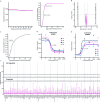Decrypting the molecular basis of cellular drug phenotypes by dose-resolved expression proteomics
- PMID: 38714896
- PMCID: PMC11919725
- DOI: 10.1038/s41587-024-02218-y
Decrypting the molecular basis of cellular drug phenotypes by dose-resolved expression proteomics
Abstract
Proteomics is making important contributions to drug discovery, from target deconvolution to mechanism of action (MoA) elucidation and the identification of biomarkers of drug response. Here we introduce decryptE, a proteome-wide approach that measures the full dose-response characteristics of drug-induced protein expression changes that informs cellular drug MoA. Assaying 144 clinical drugs and research compounds against 8,000 proteins resulted in more than 1 million dose-response curves that can be interactively explored online in ProteomicsDB and a custom-built Shiny App. Analysis of the collective data provided molecular explanations for known phenotypic drug effects and uncovered new aspects of the MoA of human medicines. We found that histone deacetylase inhibitors potently and strongly down-regulated the T cell receptor complex resulting in impaired human T cell activation in vitro and ex vivo. This offers a rational explanation for the efficacy of histone deacetylase inhibitors in certain lymphomas and autoimmune diseases and explains their poor performance in treating solid tumors.
© 2024. The Author(s).
Conflict of interest statement
Competing interests: B.K. is founder and shareholder of OmicScouts and MSAID. He has no operational role in either company. All other authors declare no competing interests.
Figures













References
-
- Meissner, F., Geddes-McAlister, J., Mann, M. & Bantscheff, M. The emerging role of mass spectrometry-based proteomics in drug discovery. Nat. Rev. Drug Discov.21, 637–654 (2022). - PubMed
-
- Geoffrey, M. C. Pharmacology, part 1: introduction to pharmacology and pharmacodynamics. J. Nucl. Med. Technol.46, 81 (2018). - PubMed
-
- Swinney, D. C. Biochemical mechanisms of drug action: what does it take for success? Nat. Rev. Drug Discov.3, 801–808 (2004). - PubMed
MeSH terms
Substances
Grants and funding
LinkOut - more resources
Full Text Sources

